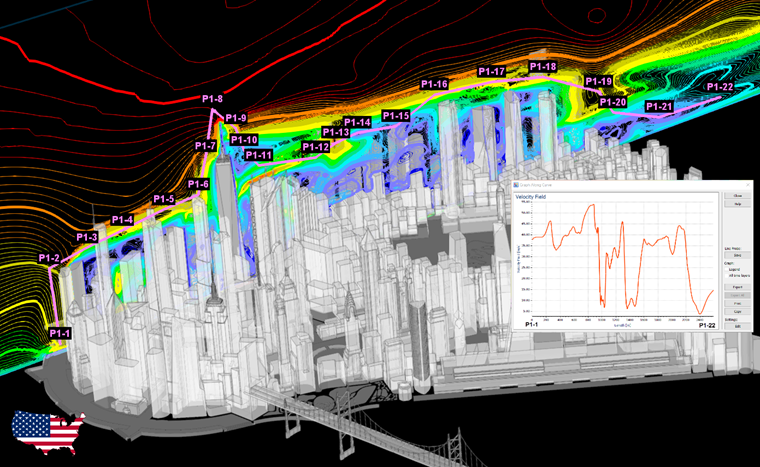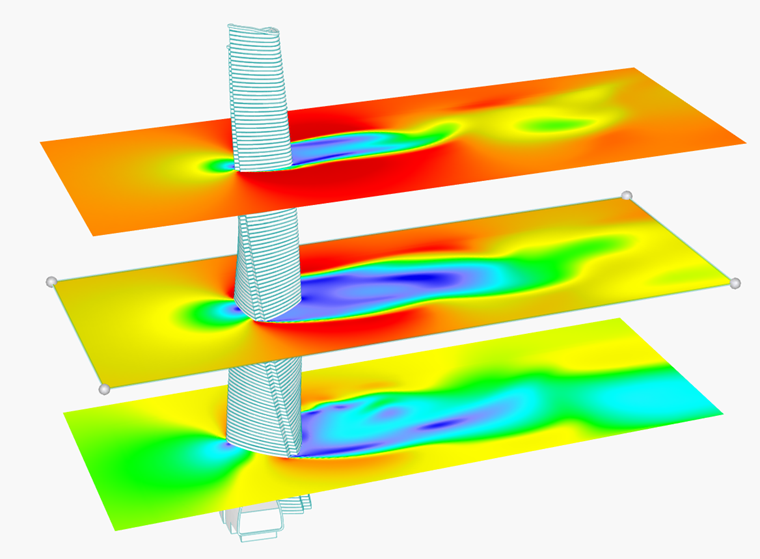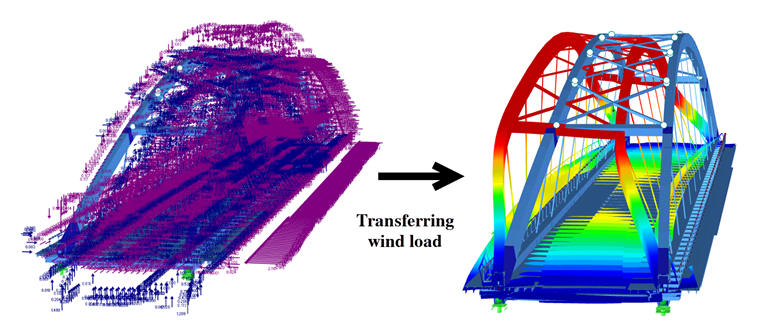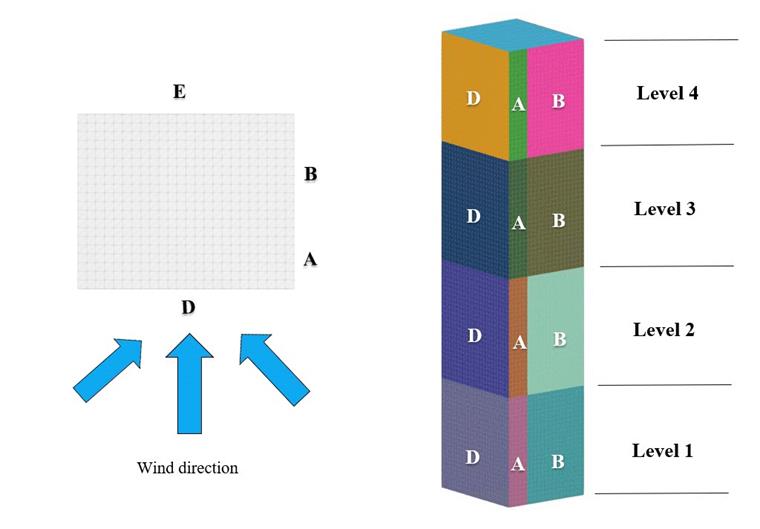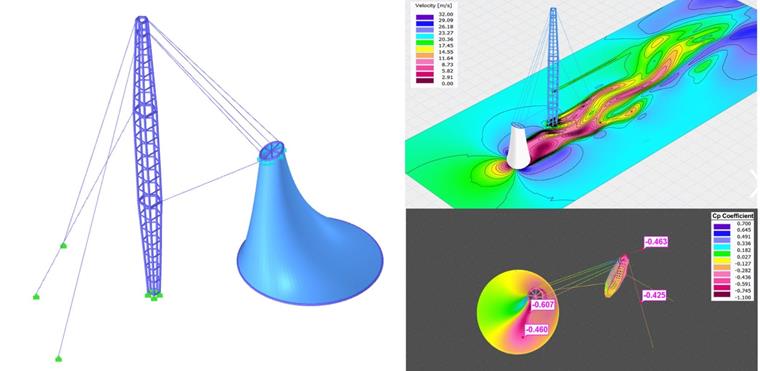Introduction
Wind engineering is a multidisciplinary field that focuses on understanding and analyzing the behavior of wind and its effects on structures, buildings, and the environment. It plays a crucial role in designing safe, efficient, and sustainable infrastructures while harnessing the power of wind energy for various applications. Wind engineering combines principles from meteorology, fluid dynamics, civil engineering, and architecture to study how wind interacts with structures.
The primary goal is to ensure the safety and stability of buildings and other constructions under varying wind conditions. Engineers and researchers use mathematical models and wind tunnel testing to simulate real-world scenarios and gather data to develop effective design solutions.
In this article, we will delve into the significance of wind engineering and its role of it in standards and how to comply with them, especially in EN 1991-1-4 [1]. Here are some examples of wind simulation applications in a modern city with skyscrapers (Image 1), wind velocity field on a tower (Image 2), and wind-structure interaction using RWIND and RFEM for a bridge (Image 3).
Method of Wind Load Calculation
The importance of wind-structure interaction has risen in recent years due to an increasing number of structures of varying heights and shapes. Experimental and numerical approaches are used to determine the interaction. Many structures are being evaluated in wind tunnels as part of the experimental investigations. In this approach, the impacts caused by wind loads can be calculated. Large-scale structures, such as tall buildings, bridges, and stadiums, benefit greatly from wind tunnel testing, but they are very expensive and time-consuming methods.
Structural wind loads can also be determined using CFD simulation, which is the cheaper and faster approach. It is important to note that based on ASCE7-22 and EN 1991-1-4, which implies that only verified and validated numerical CFD simulation can be used as an effective method.
Important Principles and Validation Examples
Here are some important criteria that wind engineers need to consider when using CFD simulation as computational techniques for estimating fluid flow in motion.
There is a variety of software out there that can help with CFD problems, and RWIND is a very user-friendly and powerful tool for structural engineers. RWIND Simulation is particularly useful for engineers and designers who need to understand how wind affects buildings, bridges, towers, and other structures.
By creating a 3D model of the wind flow, this software can help in assessing wind loads, analyzing wind comfort, and ensuring that structures are designed to withstand wind forces. The impacts of static wind load on structures can be estimated using one of the different standards and also interesting to make a comparison with CFD simulation. There are available Eurocode validation examples using RWIND to introduce the most compatible setting for CFD simulation.
Standards
The Eurocode is frequently used to make wind calculations in European countries. To make those calculations, the dynamic wind load is simplified to a conservative equivalent static load with considering safety factors. An alternative to calculating wind loads is a physical wind tunnel test. EN 1991-1-4 provides instructions on how to determine the natural wind forces that need to be accounted for in the structural design of a building or other structures for each of the loaded regions. This addresses the entire structure, components of the structure, or items linked to the structure, such as elements, cladding units, and their fixings, safety, and noise barriers [1].
In Chapter C31 of ASCE 7-22 [2] related to wind tunnel procedure, there are important points about CFD simulation which mentions:
The ASCE 49 specifies the requirements for appropriate wind tunnel testing. To calculate wind loads using numerical or actual wind tunnel testing, such a standard is necessary. Although the usage of computational fluid dynamics (CFD) simulations in wind engineering applications is on the rise, ASCE 49 does not clearly list all the steps required for CFD. Any use of CFD to estimate the design main wind force resisting system (MWFRS), C&C, or other structures' wind loads requires a peer review and verification and validation (V&V) study while we wait for a similar standard outlining the procedures required to obtain reliable and accurate wind loads using CFD tools [2]. This is required to handle quality assurance and quality control of this procedure as there isn't a standard [3].
Many of the specifications outlined in ASCE 49 for physical wind tunnel testing are valid when utilizing CFD as a numerical wind tunnel. For instance, the numerical model also requires a sufficient wind flow, precise geometry, the inclusion of major adjacent structures, and consideration of the possibility of modal excitation and aeroelastic effects. The CFD simulation, if validated against a base-case physical model, can assist in resolving subtleties that the physical model cannot measure and/or enable sensitivity analysis for parametric changes. One of the significant benefits of RWIND is its integration with DLUBAL's other software products, such as RFEM (Finite Element Method software) and RSTAB (framework analysis software). This integration allows for seamless transfer of wind loads derived from RWIND to structural analysis and design (Image 3 and 5).
The numerical wind tunnel simulations may only be regarded as qualitative data in the absence of such validation. When design information is necessary for the following wind-induced stresses, wind tunnel experiments are frequently used as the last option.
- Stresses arising from instabilities, such as flutter or galloping
- Curtain wall pressures resulting from uneven geometry
- Across-wind and/or torsional stresses
- Periodic loads induced by vortex shedding
Using CFD Simulation for Calculating Wind Load in Eurocode
Eurocode provides guidelines (specifically Eurocode 1, Part 4: Wind Actions) for determining wind loads on structures. CFD simulations can be employed to assess wind flow patterns around buildings and accurately calculate the wind loads acting on various surfaces of the structure. Here's how CFD simulation can be used for calculating wind load in Eurocode:
- Understand the building code requirements: Every city, state, or country may have different building codes. Some might adhere to international standards, while others might have more specific local guidelines. You need to understand the specific requirements for your project location.
- Define the geometry: The first step is to create a detailed 3D model of the building or structure in the CFD software. This model should accurately represent the shape, size, and features of the structure, including any surrounding terrain or neighboring buildings that may influence the wind flow. The terrain categories in Eurocode 1 are used to define the characteristics of the terrain, which in turn affects the wind speed and pressure that acts on the structure. These categories are used to determine the terrain roughness and ground roughness length, which then affects the wind velocity profile and the wind actions on a structure. This information is vital in the structural design to ensure that the building or structure can withstand the wind loads expected for its location and surrounding terrain.
- Set boundary conditions: Define the boundary conditions for the CFD simulation, including the wind speed, direction, and turbulence intensity. These boundary conditions are typically based on historical weather data or specific wind design criteria provided in Eurocode.
- Mesh generation: Create a mesh grid around the building geometry to discretize the fluid domain. The mesh resolution should be fine enough to capture the relevant flow features and boundary layer effects near the building surfaces.
- Solving the equations: CFD software solves the governing fluid flow equations (Navier-Stokes equations) numerically for the defined boundary conditions. The software calculates the velocity and pressure fields around the building.
- Validation: Compare your CFD results with wind tunnel tests or empirical data to validate your findings.
- Post-processing: Once the CFD simulation is complete, post-processing is done to analyze the results. This involves extracting data on wind pressures, forces, and velocities acting on the building surfaces.
- Wind load calculation: Based on the pressure distribution obtained from the CFD simulation, wind loads on different surfaces of the building are calculated following Eurocode guidelines. The pressure coefficients are used to determine the wind loads on walls, roofs, and other components.
- Load combination: Wind loads calculated from CFD simulations are then combined with other relevant loads, such as dead loads, live loads, and snow loads, as per Eurocode load combination rules.
- Structural analysis: The wind loads, along with other loads, are used as inputs for the structural analysis of the building to assess its stability and integrity under various load scenarios.
- Optimization: Modify the design to mitigate any high-pressure areas or other potential problems identified by the CFD analysis.
- Peer review or third-party verification: Depending on the complexity of the building and local regulations, you might need to have your designs and CFD results reviewed by a third party. This is an additional step to verify that your design meets the building code requirements.
Conclusion
In the context of building codes and wind loads, CFD can be used to simulate how wind interacts with a building, providing a more detailed and accurate understanding of the wind loads than simple formulas can achieve. It is important to note that CFD simulations for wind load calculations require expertise in both CFD modeling and knowledge of Eurocode guidelines. Additionally, the accuracy of the simulation depends on the quality of the building model, the choice of boundary conditions, and the mesh resolution.
However, it is important to note that while CFD can provide valuable insights, it is a tool that should be used in conjunction with, not in place of, the requirements and standards laid out in the building codes. It is also necessary to have a solid understanding of fluid mechanics and numerical methods to correctly interpret the results from CFD simulations. Finally validations examples and knowledge base articles are useful sources to find most compatible numerical setting with standards.
